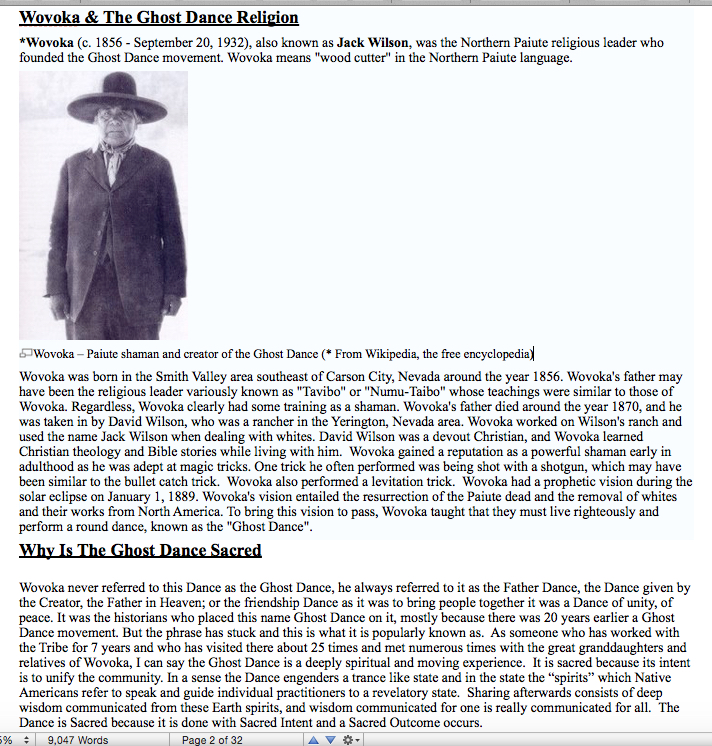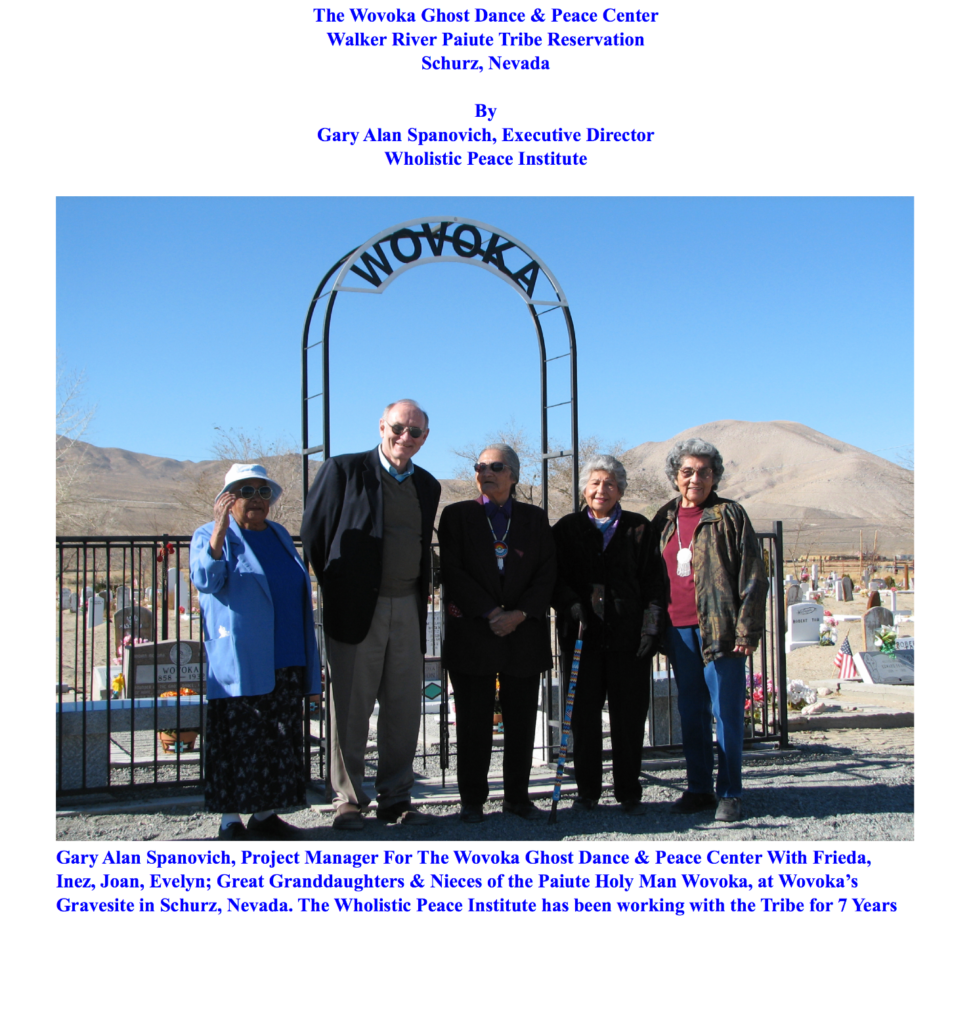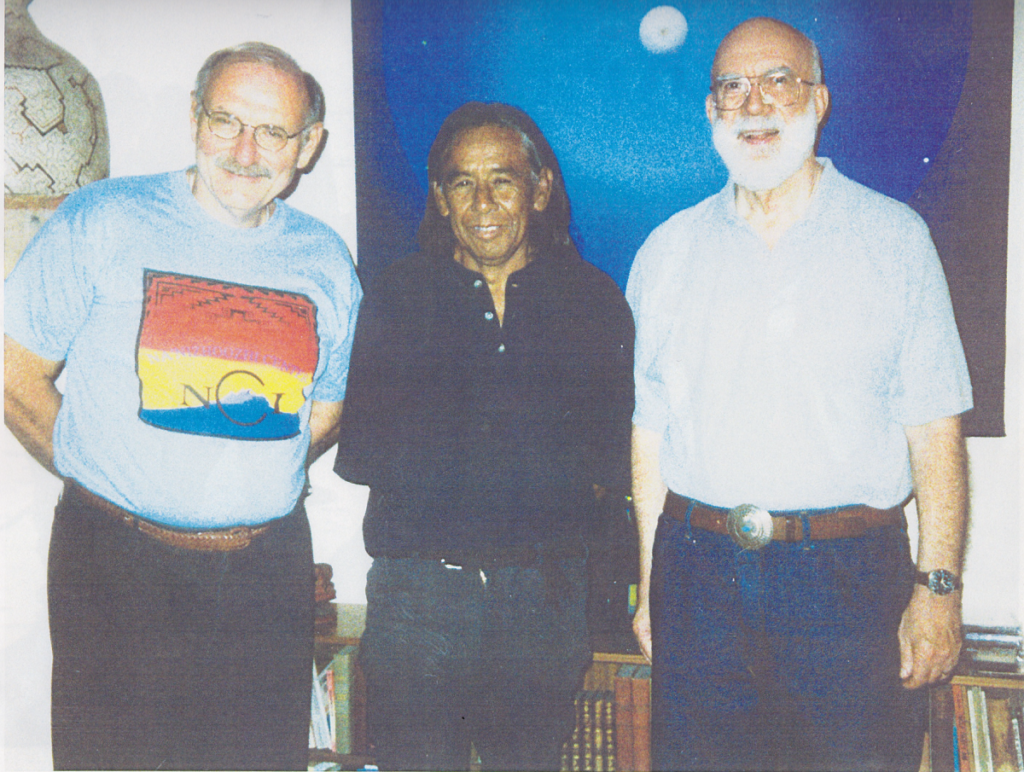How The Native American Peace Project Began
One day in the fall of 2000, a friend of mine, Tom Purkey and I were coming back from a desert sojourn in Saline Valley, California. Tom asked me if I wanted to visit Wovoka’s gravesite. Wovoka, the Paiute prophet who lived from 1856 until 1932 on the Walker River Paiute Tribal Reservation, brought a ceremony which became known as the Father Dance to most western United States Tribes. When I stood by Wovoka’s gravesite, meditating I heard a still small Voice say to me, “help the Tribe develop a memorial to Wovoka, he was a true saint and performed many miracles to help his people”.
I felt somewhat energized by my experience and so we drove to the Tribal offices, where I walked in and literally talked to the first person I met. It turned out to be Ms. Vernadine McLain, Vice-Chairman of the Walker River Paiute Tribe. When I related my experience at the gravesite, she did not miss a beat, but said, “We have wanted to develop something for Wovoka for years but don’t know how to begin the project”. I let her know I had developed such projects before and felt that with Wovoka’s incredible holiness that creating a museum or memorial around him was practical and could also be very healing for Native American youth.
When I returned home I immediately called Dr. Michael Harner, Director of the Foundation For Shamanic Studies and told him of my experience for it was with Michael that I first learned of the Father Dance Ceremony (the historians always called it the Ghost Dance Ceremony). He left a message that said that he too felt moved by Wovoka and had wanted to try and assist with such a project for some time, to this holy man.
I first did the Father Dance Ceremony with Michael Harner in 1987 at Joy Lake, Nevada and for me it was a profound healing experience. Later after further work with Michael at Esalen and the Ceremony, I began to lead the Father Dance Ceremony, perhaps two dozen times in the early nineties. Once I had over 100 people attend and the energetic healing experience in the room was very present. The Father Dance Ceremony, my experience of it at least is that it brings a collective healing to the group that participates in it. I can think of now greater ceremony that the average person can share in with little or no experience.
After some months of correspondence with Vernadine, Tom and I headed back to Saline Valley for our annual sojourn in the desert. Saline Valley has played a key role in my spiritual development since 1988, when I began to hear a “still small Voice” within. I went there after spending two weeks with Michael Harner at Esalen and had a life changing experience in that desert. When we came back through Schurz, Nevada we met this time with Raymond Hoferer, who became our lead person in coordinating with the Tribe on the project.
Raymond was given the title, Father Dance Emissary and given the responsibility of reviving the Father Dance Ceremony and also to coordinate the development of a living memorial to Wovoka. He has reached out to many tribes across the West and discussed the return of the Ceremony with them. His feedback has been positive and all the Tribes he has talked to have encouraged the Walker River Tribe to revive the Father Dance Ceremony and to bring it back.
Raymond has also reached out to the Wounded Knee Survivors Association. One of the tragedies of the late 1800’s was the Massacre of Wounded Knee, which occurred on December 29, 1890 near Wounded Knee Creek at Pine Ridge Reservation in South Dakota. A shot rang out and the Army (many of which were remnants of the 7th Cavalry) let loose a barrage of gunfire which killed 300 Native American men, women and children.
This tragedy effectively killed the Father Dance movement and also heralded an era of repression for all Native peoples. At this point the US government made it illegal for the Native peoples to practice their religious ceremonies, speak Native languages, and participate in cultural events. Perhaps most tragic they removed Native children from their parents and placed them in Indian schools so that they would be brought up in a white cultural environment. The Father Dance Ceremony has been out of sight for the last 113 years.
What We Know Of Wovoka and His Miracles
What we know today of Wovoka and how the Father Dance Ceremony came to him is from many sources. One of them is from James Mooney who wrote The Ghost Dance Religion and Wounded Knee. While cutting wood, Wovoka fell unconscious for two days and when he awoke, claimed that God “took him to Heaven” where he saw a beautiful land filled with game. He also said he talked to Jesus Christ in his revelatory experience and that he was given a Dance to bring back to the people that would unite them in friendship and brotherly love.
In Wovoka’s own words he described his experience as, “When the Sun died, I went up to Heaven and saw God and all the people who had died a long time ago. God told me to come back and tell my people they must be good and love one another, and not fight, or steal or lie. He gave me this dance to give to my people.”
Wovoka called this dance the “Father Dance” or the Dance given by God. He also called it the “Friendship Dance” or sometimes the “Dance of Unity” for it was to unite the Indian peoples. They key aspect of his experience was that when he returned from his revelation, he returned with the ability to do miracles. Mooney documented many miracles where Wovoka was able to change the weather at will, to make objects appear, to help the sick and dying, and many more.
It was his miracles that allowed the Dance to spread across the western United States, in less than a year. The Dance was normally done for five days in a row. It was common for the white settlers around Schurz, Nevada and especially the Mormon farmers to also participate in the Dance during this time.
We have had the pleasure to work with many of Wovoka’s living relatives, including Inez Jim and Evelyn Cook, his granddaughters. They have recounted many personal family stories but the one that stands out in my mind are the times, they often went rabbit hunting with Wovoka. He would run out of bullets and would simply put sand down the barrel of his gun and miraculously, bullets would come out. Such was the miracles of this holy Paiute prophet.
Where We Are Now With Developing the Wovoka Peace Center
The Tribe has a large vision for the Wovoka Peace Center. It would be first a national museum, developed to the standards set by the Smithsonian Museum, so that all the artifacts of Wovoka that is now stored in other museums could be brought home to Nevada. It would also in later phases be developed as a Native American teaching institution that would teach on indigenous language, culture, religion and philosophy. It would also have over time a conference and mediation center where tribal and tribal and non-tribal controversies could be settled in an atmosphere of peace and reconciliation. A world peace center would eventually be developed that would be devoted to the preservation of indigenous culture all over the planet. Finally the Center would be the nucleus of the revival of the Father Dance Ceremony and would serve as a religious center for Native American spirituality.
In October, 2003 the Tribe held a national conference on Wovoka and invited all 400 Indian Tribes west of the Mississippi River to participate. Also Raymond has met twice with Michael Harner and been involved in the Father Dance Ceremony with Michael’s circles. Subsequent discussions with Tribal officials have indicated that the Father Dance Ceremony may be offered out, for the first time in 113 years, this coming September, 2004 when the Tribe holds its annual Pine Nut Ceremony. Most likely the second national conference on Wovoka will also take place then.
We have also reached out to the Nevada Congressional Delegation and asked them to help earmark funds for the development of a $5 million museum building which would form the first phase of the overall project. The Tribe felt that it was important to name it a Peace Center for a variety of reasons: because this was the Spirit which Wovoka offered the Dance out and to ensure that history does not repeat itself. The Dance Ceremony can heal, has healed and will heal as it occurs again. The Ceremony is needed today in our fractured and broken world where wholeness is often forgotten about.
A Way Of Offering Out This Dance Of Peace To The World
It is possible to contain this Father Dance, as Wovoka called it in a performance that can be done on the concert halls of the world. With a troupe of 100 drummers, a full symphony orchestra and with a troupe of actors and actress, the Dance of Peace could be brought to a large audience. Discussions are underway now in Portland to see if this can be first accomplished here.



